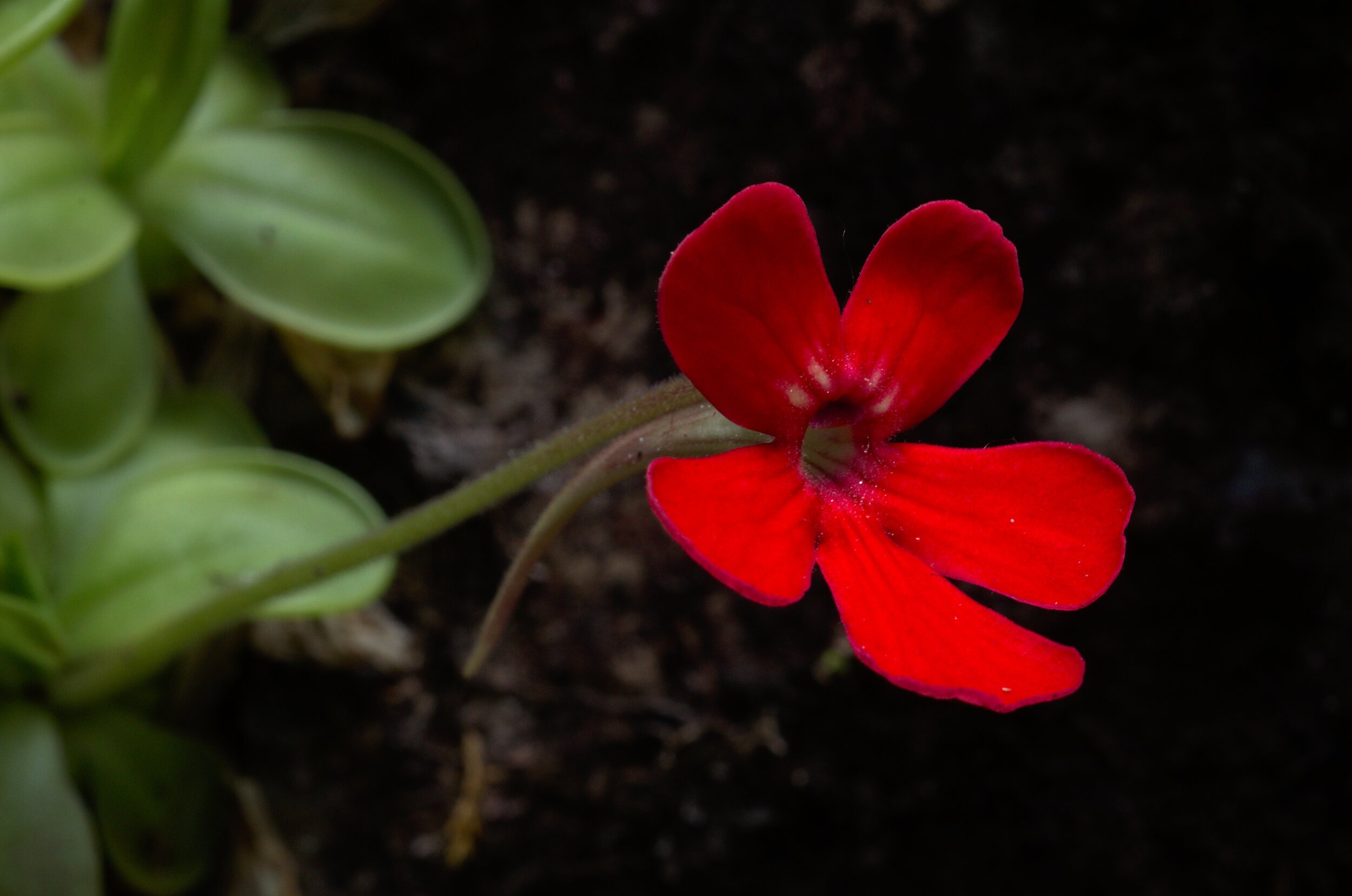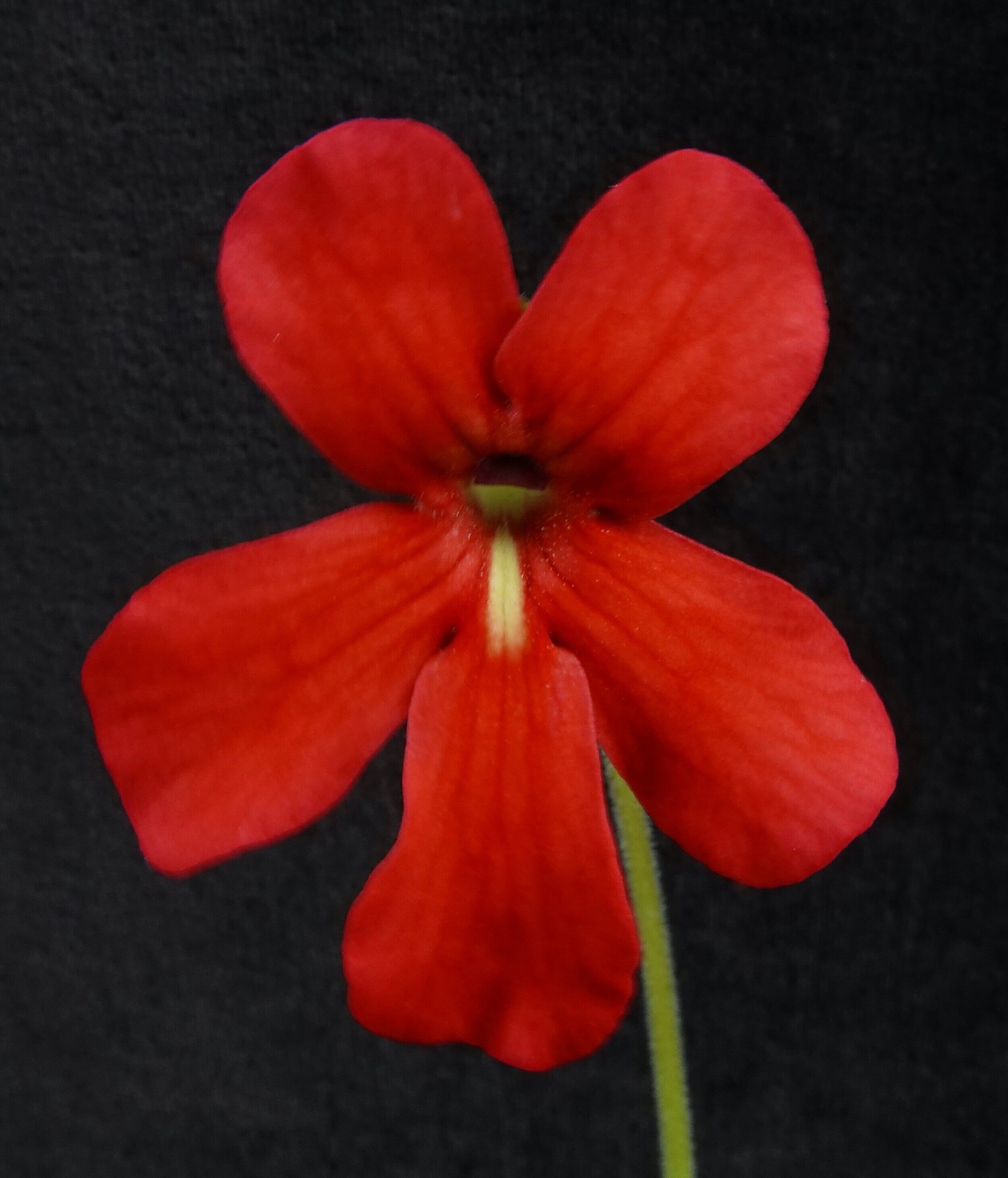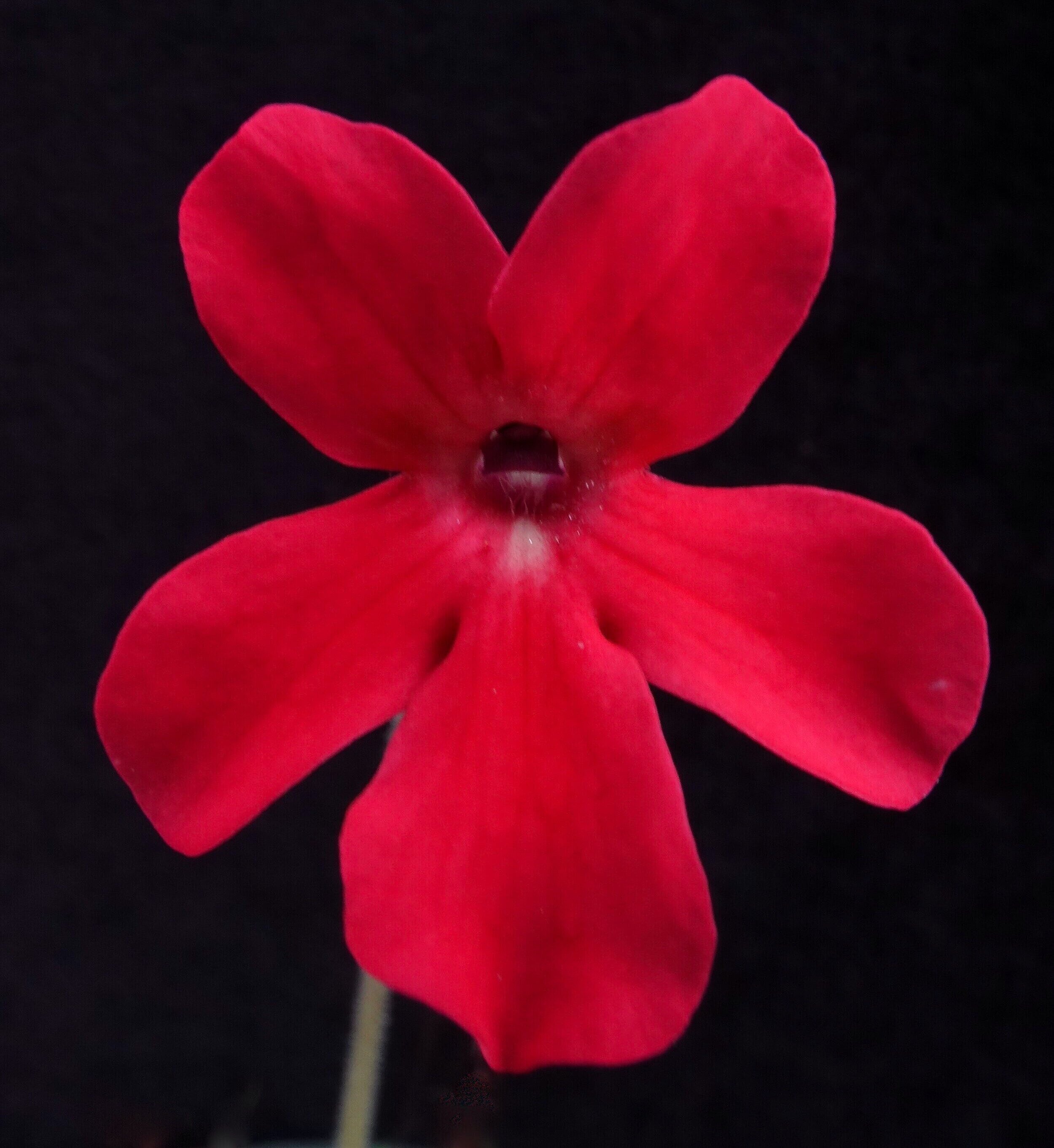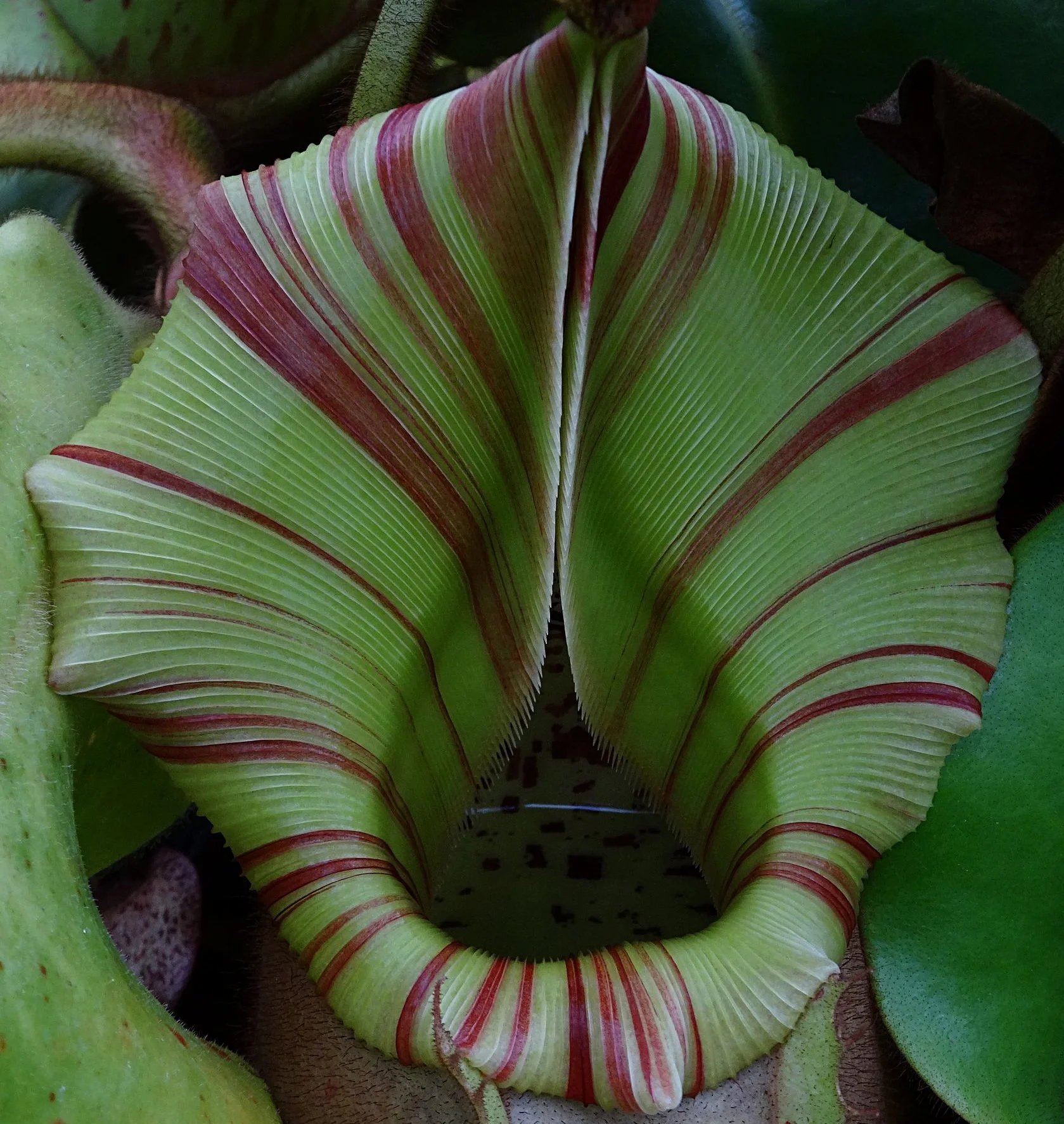In the Court of the Red Queen
A trip to wonderland
by Jay Vannini
Pine-oak association in montane cloud forest at the type locality of Pinguicula laueana in central Oaxaca. Image: F. Muller.
A steep rock slope showing typical habitat for Pinguicula laueana. Many Mesoamerican butterwort species are lithophytes and occur in similar settings. Image: F. Muller.
A small colony of Pinguicula laueana showing some variation in flower shape and color tone. Image: F. Muller.
Another aspect of a Pinguicula laueana colony in May 2011. Image: F. Muller.
Detail of a well-flowered Pinguicula laueana colony in May 2011. Image: F. Muller.
A nice group of dark red Pinguicula laueana and miniature lycopodiums. Image: F. Muller.
Below, two exceptional wild clones of Pinguicula laueana emerging from winter and early spring dormancy, showing excellent corolla form, size and color. Frankly, with one or two exceptions, I have yet to see comparable flower quality in cultivated plants. Images: F. Muller.
Showy-flowered Mesoamerican butterworts (Pinguicula species) emerged from relative obscurity in 1998 upon the publication of Peter D’Amato’s superb book on carnivorous plants (CP) and their care, “The Savage Garden”. More than any other individual, I believe that D’Amato generated the unprecedented wave of interest in cultivating this formerly obscure but beautifully flowered and interesting carnivorous plant group that continues through today.
A handful of beautiful Pinguicula crassifolia blooms emerging from dormancy during March in Hidalgo State, México. Image: F. Muller.
Around the same time, French CP enthusiast Eric Partrat reached out to researchers in the region and provided interested growers with images and information on the genus in nature at his collaborative website, “A World of Pinguicula”. Subsequent print publications, such as Lampard et. al. “Pinguicula of Latin America” (2016) provided handy illustrated references for growers interested in Neotropical diversity the genus. While several of the more desirable Mexican and Guatemalan species can be delicate and often fussy in cultivation (e.g. P. calderoniae, P. clivorum, P. crassifolia and P. medusina), most forms are relatively easy in cultivation as sunny windowsill subjects if recommended general care and watering regimens are followed.
Without a doubt one of the most striking of all butterwort species is the red-flowered Oaxacan endemic, Pinguicula laueana. It was discovered by Alfred Lau near San Pedro y San Pablo Ayutla in the high parts of the Sierra Mixe of the central part of that state in 1973 and later grown in his garden in Fortín de las Flores in Veracruz. More than a decade after it was found, it was determined to be a new butterwort species and described from cultivated material that Lau had sent to botanists at the Linz Botanical Garden (Speta and Fuchs 1989). Until the early 2000s, little was known about this species in the wild, and very few clones circulated in cultivation. Indeed, the original seed-grown material Lau sent to Austria in the 1980s continues to circulate today under accession numbers “SP1” and “SP2” as well as “CP1” through “CP3”. Lau later reported population declines at the type locality that appear to have been erroneous. There have been crosses made between clones, especially those with cerise and magenta colored flowers. Besides the Lau accessions, some US and European plant collectors later added wild-source plants to the inventory of lines available to CP growers. Leaf color also varies considerably from pale green to pale violet. There appears to also be some variation in the amount of red or purple expressed in the leaves of the different clones grown under identical environmental conditions.
A very fine group of cultivated Pinguicula laueana ‘CP2’ flowering in a collection in California. Image: R. Parsons.
While there are unconfirmed reports from other sites, this species is believed to have a restricted distribution near the type locality in central Oaxaca. It occurs at upper elevations between about 7,500 and 11,700’/2,300 and 3,500 masl so Pinguicula laueana obviously exhibits some cold tolerance in cultivation if kept on the dry side when semi-dormant. While most plants have bright red flowers, there is some color and shape variation among the wild population as is evident in the group photos shown here. The most unusual of these is the magenta colored form mentioned above, known in cultivation as CP3. As noted previously, there has also been some line breeding in the EU and the U.S., as well as later introductions of wild-collected plants in the 1990s and 2000s that has produced some improved plant forms.
Above left, variation in flower form in a trio of wild wild plants. Image: F. Muller. Right, flower size and shape variation in two cultivated clones grown by the author in California.
In plants in horticulture, besides the usual variability in flower color shades, corolla shapes also vary from those with very rounded, sometimes overlapping lobes and others with very long, narrow lobes that impart a “stellate” appearance to the flower. At least two clonescirculating inthe trade have backswept corolla lobes that give them a rather distorted appearance. Most flowers are scarlet or crimson in color, but shades range from pale salmon to ruby red and magenta. The amount of white on the flowers also varies between clones. Most show small white or whitish patches in the throat or as “eyelashes” above it, however some of the finest forms currently in cultivation (e.g. ‘Geoff Wong’ and others) lack these markings and are pure red.
Above left, very good flower quality on a cultivated plant in the SF Bay Area resembling a clone associated with the late local CP grower, Geoff Wong. Image: R. Parsons. Right, a very pale colored flower on a clone obtained from a Czech nursery as ‘Garden of Eden’. Shape and plant vigor is dreadful, but the pale salmon color is noteworthy. This clone bears a strong resemblance to some of those generated from a Pinguicula (laueana x emarginata) x laueana cross made in the UK about a decade ago.
While generally observed in nature as a terrestrial or lithophyte, like many Mesoamerican butterwort species it may also be found growing as an opportunistic epiphyte. Image shown right, F. Muller.
Complete dormancy seems cyclical rather than annual when cultivated by me in California and Guatemala but is reportedly marked and seasonal in wild populations. I have had plants flower throughout the year with peaks in the mid-summer through early fall, with best flower form and size evident later in the season. They can flower in cultivation through until mid-winter. Wild plants flower just after they expand from small, “winter” rosettes to “summer” rosettes, mostly in middle to late spring.
A group of Pinguicula laueana emerging from cool dormancy in late May. Image: F. Muller.
Like many of the lithophytic Mesoamerican pings, I start these as offsets in pure NZ sphagnum moss then move on to display in a mix of ~50:40:10 Fluorite or Turface (= Seramis in the EU) and fine grade pumice combined with a small amount of milled sphagnum peat to improve moisture retention. Rinse the first two components thoroughly prior to use.
My ~1,000+ examples of cultivated Neotropical pings are splashed with soluble orchid fertilizers (~60-90 ppm N) on a fairly frequent basis and are watered copiously almost year-round with local tap water because of their bench location adjacent to or under mounted miniature orchids in the greenhouse. With the exception of a few species that do have an obligate dormancy (e.g. Pinguicula gypsicola, P. macrophylla), plants don’t appear to resent either “over” watering nor “over” fertilization; quite the contrary.
Very color saturated winter rosette of Pinguicula laueana shown in nature. ©F. Muller 2020.
Note: due to occasional, largely unexplained die offs of some individual captive Mexican pinguiculas even under the best conditions, I recommend starting as many additional plants from leaf pulls as early in the growth cycle as possible to have backup propagations in case the source plant/s crash/es. This is especially true of the gypsum loving Mexican species.
Vigorous, one year old seedlings of Pinguicula laueana bred and cultivated by the author. Several plants from this group flowered at 20 months of age.
As is also the case in many Mesoamerican butterworts, this species appears to be self-sterile so at least two individual clones are required for successful breeding. Seed can be started in vitro or on steam-sterilized cotton facial pads placed in bleach-treated transparent containers. These containers can then be grown on under lights or in a warm, bright location. Both these methods can produce high percentages of flowering plants within 18 months of seed sow. Germination times can vary considerably, but I have recently had seed from fully ripe pods germinate under near-sterile conditions in nine days. Personally, I no longer bother sowing seed on unsterilized substrates since losses are too high to risk valuable material.
First flower on one of the better quality seedlings shown above right. Image taken in late January 2020, 22 months after seed sow. The flower diameter at widest point was 1.75”/44 mm. Note that the plant is not dormant despite being shown growing in a cool greenhouse in mid-winter,
I have grown propagates of wild-collected plant material, vegetative propagations of most of the numbered Lau accessions as well as a few of the crosses between the Lau clones made in the EU. I have also started my own select lines from an in-house breeding project. While images posted on the internet evidence that there are some very fine-looking Pinguicula laueana growing in the UK, Germany and France, these plants appear hard to obtain. The material that I have grown out of EU origin PTC in Guatemala and California has been uniformly weak and maladapted, whatever its nursery source. Some misidentified hybrid plants are in the U.S. trade are circulating as the ‘CP2’ and CP3’ clones. Demand is very high for attractive clones in the U.S. and the EU, so line breeding seems the best option to improve plant vigor and often mediocre existing flower form. The recent interest in native Pinguicula species by Mexican CP enthusiasts will certainly translate (or already has) into many other noteworthy wild clones finding their way into foreign collections.
My limited experience crossing select wild origin forms of Pinguicula laueana with one of the old Lau clones show that notable improvements in flower size, form and color as well as overall plant vigor can be achieved at F1. Further breeding of plants with exceptional flowers, such as that shown left, provide a valuable stepping stone towards unlocking the potential of this species in cultivation. I have now germinated seed from F2s of the plant shown left, among others, and expect exceptional flower quality in these seedling batches.
Like Pinguicula mesophytica and the white and semi-alba flowered forms of P. moranensis, this species is an exceptional subject for display as a mass planting in decorative ceramic containers. Use of attractive stone as a visual accent can improve overall interest to viewers.
A display of a single Pinguicula laueana clone (‘BR’, a form believed to be of wild origin) grown by the author preparing to flower in late October in northern California. Staged in a 9”/23 cm terra cotta bowl filled with the mostly mineral substrate described in the text.
Hybrids using Pinguicula laueana have been made in both the EU and the U.S. Unfortunately for breeders, the red color seems to be recessive in crosses with purple flowered Mesoamerican butterwort species and hybrids and only a handful made so far are noteworthy.
Two much improved F1 Pinguicula laueana bred by the author with 1.50-1.75”/3.75-4.40 cm corolla spans, good form and excellent color, flowering in March 2020. As plants with higher flower quality are selectively bred into F2, I would expect to see very good to excellent P. laueana available on the market by late 2021.
Presumably, continued outcrossing the different accessions of Pinguicula laueana will ultimately yield a clone lacking red pigments, in this case a f. aurea rather than an alba. Other than the U.S. Gulf Coast native, P. lutea and the extremely pale-colored Czech hybrid P. ‘Golden Eye’, this color has so far eluded butterwort collectors.
In closing, Fred Muller has hit a home run yet again with the incomparable set of images shown above that were shot in nature in Oaxaca during the spring of 2010 and 2011. I doubt that there is anything like his collection of Mexican butterwort photographs shown anywhere else. Ron Parsons also showcases some of his beautiful photographs of exceptional examples of this species taken in cultivation the San Francisco Bay Area. Both Fred and Ron have extensive experience with Neotropical pinguiculas in nature and as growers themselves, so they bring very discerning eyes to the subject matter. Many thanks to both.
Another very fine wild flower of Pinguicula laueana with a very well-defined and conspicuous white flash mark. Image: F. Muller.
All content ©Exotica Esoterica LLC® 2019-2025, ©Fred Muller 2019 and ©Ron Parsons 2019
Follow us on:





















